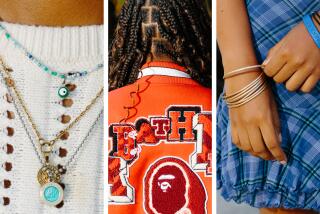New Goldman Sachs dress code points to a sartorial double standard in the workplace
- Share via
Goldman Sachs, one of the last bastions of crisp-collared, bespoke-suited workplace attire, has loosened up. It announced an official “firm-wide flexible dress code” earlier this month. And at last — after the long, slow undoing of corporate formality — business casual seems to have triumphed in the American workplace.
But for women and minorities who have been playing corporate catch-up for decades, a more casual dress code presents its own complications.
As one Goldman Sachs banker in GQ put it: “All the men are psyched.”
For everyone else, dressing more casually for work can be fraught, even risky. Over decades, expensive suits have projected power on Wall Street, almost like a piece of “armor,” said Susan Scafidi, academic director of the Fashion Law Institute at Fordham University.
Women at work who feel pressure to prove they deserve to be in the room might be wary of ditching their blazers and pumps.
“We’ve just achieved the parity of the pantsuit, and suddenly we’re told the standard pantsuit is no longer standard workforce attire,” Scafidi said. “Women will need to find another way to achieve parity in attire at business-casual or some other lower level of formality.”
Parity, of course, extends not only to power but also to pay. Jaclyn Wong, who researches the intersection of gender and professional life, co-published a study in 2016 looking at the differences in how men and women are rewarded for attractiveness in the workplace.
Attractive men and women make roughly 20% more than their less attractive co-workers, Wong found. Even so, they are measured by different standards.
For women, perceived attractiveness was based on grooming, like hairstyle, makeup, fitness and clothing. They are rewarded, Wong said, for looking the part.
For men, grooming counts far less. If attractive, they tend to be rewarded whether they are well-groomed or not.
“We know that appearance matters for women and people of color in being seen as competent and worthy of respect,” said Wong, a professor of sociology at the University of South Carolina. “It becomes this difficult position: ‘Do I want to dress down because I don’t want to be seen as this kind of stiff and un-fun person, or do I want to continue dressing up because that’s the only way people will treat me with respect?’ “
Goldman Sachs is following other firms in a hunt for tech talent that is most comfortable with the sneakers and hoodies of Silicon Valley. Also it is accommodating a growing fraction of its workforce that is made up of millennials — with about 75% of its workers under 40 — and dressing in a way that fits more casually dressed clients.
The investment bank, which announced the change in a memo, called for employees to “please dress in a manner that is consistent with your clients’ expectations,” but stressed that they should “exercise good judgment.” A spokeswoman declined to comment beyond the memo.
“Good judgment,” of course, is open to interpretation.
“You have to decide: How do you present yourself when you’re often the only woman in the room?” said Jane Newton, a managing partner at RegentAtlantic. Newton spent 17 years at JPMorgan and runs a forum for women in leadership on Wall Street. “In a male-dominated environment, gravitas becomes a key variable in decisions that are made about your potential.”
Workers tend to take their signals from the top. According to the lore of corporate America, IBM made its first big leap decades ago when executives such as Louis V. Gerstner Jr. changed up the uniform of suit and tie and white collar — by mixing in blue button-down shirts.
A 1995 headline in the New York Times read: “Black Jeans Invade Big Blue” after Gerstner said he was rolling out casual dress. Bill Hewlett and Dave Packard’s relaxed “Blue Sky Days” on Fridays were said to influence future generations of tech entrepreneurs.
Today, it’s Goldman Chief Executive David Solomon, who performs as a DJ in his spare time and has appeared in interviews without a tie.
In the ’80s and ’90s, there were few role models for women on Wall Street, Newton said, so they tried to blend in. Men in suits cut imposing figures, so women wore blazers with padded shoulders. Men wore ties, so women wore blouses with bows.
Fashion is far more flexible now, she said, but younger women still ask Newton the same questions about how to present themselves to be taken seriously. Sometimes she offers to go shopping with them, or she pages through catalogs to show what works and what doesn’t.
“When a woman is dressed informally, she’s more likely to be assumed to be more junior” or to be someone’s assistant, said Laura Sherbin, managing director of Culture@Work, a division of Working Mother Media that helps companies develop best practices around diversity. The topic of dress codes still comes up all the time in focus groups she does at companies, she said.
Maureen Sherry worked 12 years on Wall Street and was the youngest managing director at Bear Stearns.
“A friend of mine wore the first pantsuit on the Salomon Bros. trading floor in 1991, and it caused an uproar,” she said. “She still has it” as a kind of trophy.
Today, she said, “if you saw a woman wearing Birkenstocks or loafers, we’d like to think that we’re not taking her less seriously as a result, but I’m not sure if that’s true.”
McGregor writes for the Washington Post.
More to Read
Inside the business of entertainment
The Wide Shot brings you news, analysis and insights on everything from streaming wars to production — and what it all means for the future.
You may occasionally receive promotional content from the Los Angeles Times.










